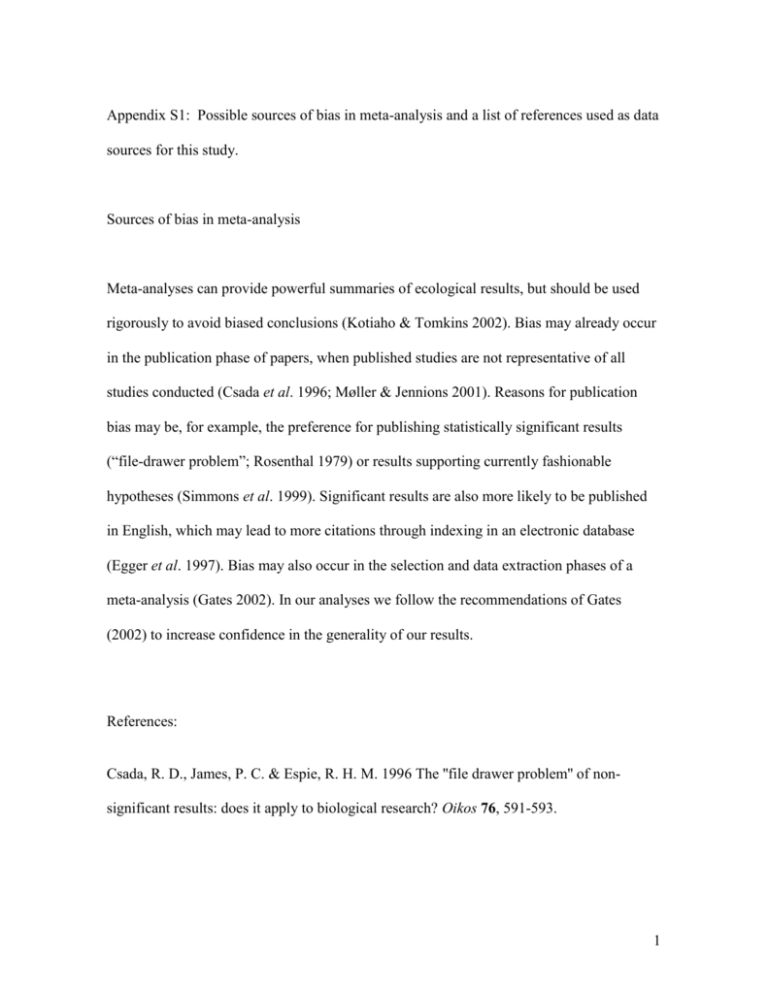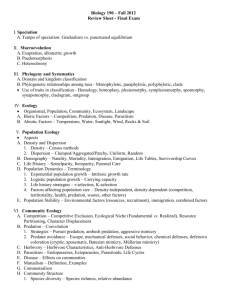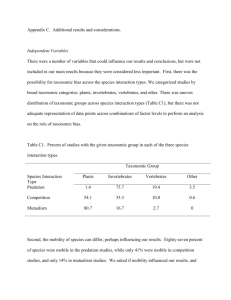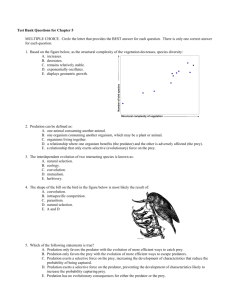supporting information - Proceedings of the Royal Society B
advertisement

Appendix S1: Possible sources of bias in meta-analysis and a list of references used as data sources for this study. Sources of bias in meta-analysis Meta-analyses can provide powerful summaries of ecological results, but should be used rigorously to avoid biased conclusions (Kotiaho & Tomkins 2002). Bias may already occur in the publication phase of papers, when published studies are not representative of all studies conducted (Csada et al. 1996; Møller & Jennions 2001). Reasons for publication bias may be, for example, the preference for publishing statistically significant results (“file-drawer problem”; Rosenthal 1979) or results supporting currently fashionable hypotheses (Simmons et al. 1999). Significant results are also more likely to be published in English, which may lead to more citations through indexing in an electronic database (Egger et al. 1997). Bias may also occur in the selection and data extraction phases of a meta-analysis (Gates 2002). In our analyses we follow the recommendations of Gates (2002) to increase confidence in the generality of our results. References: Csada, R. D., James, P. C. & Espie, R. H. M. 1996 The ''file drawer problem'' of nonsignificant results: does it apply to biological research? Oikos 76, 591-593. 1 Egger, M., Zellweger-Zahner, T., Schneider, M., Junker, C., Lengeler, C. & Antes, G. 1997 Language bias in randomised controlled trials published in English and German. Lancet 350, 326-329. Gates, S. 2002 Review of methodology of quantitative reviews using meta-analysis in ecology. Anim. Ecol. 71, 547-557. Kotiaho, J. S. & Tomkins, J. L. 2002 Meta-analysis, can it ever fail? Oikos 96, 551-553. Møller, A. P. & Jennions, M. D. 2001 Testing and adjusting for publication bias. Trends Ecol. Evol. 16, 580-586. Rosenthal, R. 1979 The "File Drawer Problem" and tolerance for null results. Psychol. Bull. 86, 638-641. Simmons, L. W., Tomkins, J. L., Kotiaho, J. S. & Hunt, J. 1999 Fluctuating paradigm. Proc. R. Soc. B. 266, 593-595. Below we list the sources of data for the meta-analysis: 45 replicated studies and 30 unreplicated studies. Numbers refer to respective rows in the dataset tables Table S1 for replicated experiments and S2 for unreplicated experiments. Replicated studies 2 1. Balser, D. S., Dill, H. H. & Nelson, H. K. 1968 Effect of predator reduction on waterfowl nesting success. J. Wildl. Manage. 32, 669-682. 2. Banks, P. B. 1999 Predation by introduced foxes on native bush rats in Australia: do foxes take the doomed surplus? J. Appl. Ecol. 36, 1063-1071. 3. Banks, P. B., Newsome, A. E. & Dickman, C. R. 2000 Predation by red foxes limits recruitment in populations of eastern grey kangaroos. Austral Ecol. 25, 283-291. 4. Banks, P. B., Norrdahl, K., Nordström, M. & Korpimäki, E. 2004 Dynamic impacts of feral mink predation on vole metapopulations in the outer archipelago of the Baltic Sea. Oikos 105, 79-88. 5. Clark, R.G., Meger, D. E. & Ignatiuk, J. B. 1995 Removing American crows and duck nesting success. Can. J. Zool. 73, 518-522. 6. Desy, E. & Batzli, G. O. 1989 Effects of food availability and predation on prairie vole demography: a field experiment. Ecology 70, 411-421. 7. Dion, N., Hobson, K. A. & Lariviere, S. 1999 Effects of removing duck-nest predators on nesting success of grassland songbirds. Can. J. Zool. 77, 1801-1806. 8. Garrettson, P. R. & Rohwer, F. C. 2001 Effects of mammalian predator removal on production of upland-nesting ducks in North Dakota. J. Wildl. Manage. 65, 398-405. 9. Garretson, P. R., Rohwer, F. C., Zimmer, J. M., Mense, B. J. & Dion, N. 1996 Effects of mammalian predator removal on waterfowl and non-game birds in North Dakota. Trans. 61st. No. Am. Wildl. and Natur. Resour. Conf. 61, 94-101. 3 10. Graham, I. M. & Lambin, X. 2002 The impact of weasel predation on cyclic fieldvole survival: the specialist predator hypothesis contradicted. J. Anim. Ecol. 71, 946956. 11. Greenwood, R. J. 1986 Influence of Striped Skunk removal on upland duck nest success in North Dakota. Wildl. Soc. Bull. 14, 6-11. 12. Greenwood, R. J., Arnold, P. M. & McGuire, B. G. 1990 Protecting duck nests from mammalian predators with fences, traps, and a toxicant. Wildl. Soc. Bull. 18, 75-82. 13. Hambäck, P. A., Oksanen, L., Ekerholm, P., Lindgren, Å., Oksanen, T. & Schneider, M. 2004 Predators indirectly protect tundra plants by reducing herbivore abundance. Oikos 106, 85-92. 14. Henke, S. E. and Bryant, F. C. 1999 Effects of coyote removal on the faunal community in Western Texas. J. Wildl. Manage. 63, 1066-1081. 15. Huitu, O., Koivula, M., Korpimäki, E., Klemola, T. & Norrdahl, K. 2003 Winter food supply limits growth of northern vole populations in the absence of predation. Ecology 84, 2108-2118. 16. Huitu, O., Laaksonen, J., Norrdahl, K. & Korpimäki, E. 2005 Spatial synchrony in vole population fluctuations – a field experiment. Oikos 109, 583-593. 17. Jackson, D.B. 2001 Experimental removal of introduced hedgehogs improves wader nest success in the Western Isles, Scotland. J. Appl. Ecol. 38, 802-812. 18. Kinnear, J. E., Onus, M. L. & Summer, N. R. 1998 Fox control and rock-wallaby population dynamics - II. An update. Wildl. Res. 25, 81-88. 4 19. Klemola, T., Koivula, M., Korpimäki, E. & Norrdahl, K. 1997 Small mustelid predation slows population growth of Microtus voles: A predator reduction experiment. J. Anim. Ecol. 66, 607-614. 20. Klemola, T., Koivula, M., Korpimäki, E. & Norrdahl, K. 2000 Experimental tests of predation and food hypotheses for population cycles of voles. Proc. R. Soc. B 267, 351-356. 21. Korpimäki, E. & Norrdahl, K. 1998 Experimental reduction of predators reverses the crash phase of small-rodent cycles. Ecology 79, 2448-2455. 22. Korpimäki, E., Norrdahl, K., Huitu, O. & Klemola, T. 2005 Predation induced synchrony in population oscillations of co-existing small mammal species. Proc. R. Soc. B 272, 193-202. 23. Korpimäki, E., Norrdahl, K., Klemola, T., Pettersen, T. & Stenseth, N. C. 2002 Dynamic effects of predators on cyclic voles: field experimentation and model extrapolation. Proc. R. Soc. B 269, 991-997. 24. Lokemoen, J. T. & Woodward, R. O. 1993 An assessment of predator barriers and predator control to enhance duck nest success on peninsulas. Wildl. Soc. Bull. 21, 275-282. 25. Lokemoen, J. T., Doty, H. A., Sharp, D. E. & Neaville, J. E. 1982 Electric fences to reduce mammalian predation on waterfowl nests. Wildl. Soc. Bull. 10, 318-323. 26. Lomolino, M. 1984 Immigrant selection, predation and the distributions of Microtus pennsylvanicus and Blarina brevicauda on islands. Am. Nat. 123, 468-483. 5 27. Marcström, V., Keith, L. B., Engren, E. & Cary, J. R. 1989 Demographic responses of arctic hares (Lepus timidus) to experimental reductions of red foxes (Vulpes vulpes) and martens (Martes martes). Can. J. Zool. 67, 658-668. 28. Marcström, V., Kenward, R. E. & Engren, E. 1988 The impact of predation on boreal tetraonids during vole cycles: An experimental study. J. Anim. Ecol. 57, 859-873. 29. Mayer, P. M. & Ryan, M. R. 1991 Electric fences reduce mammalian predation on Piping Plover nests and chicks. Wildl. Soc. Bull. 19, 59-63. 30. Meserve, P. L., Gutiérrez, J. R., Yunger, J. A., Contreras, L. C. & Jaksic, F. M. 1996 Role of biotic interactions in a small mammal assemblage in semiarid Chile. Ecology 77, 133-148. Meserve, P. L., Gutiérrez, J. R. & Jaksic, F. M. 1993 Effects of vertebrate predation on a caviomorph rodent, the degu (Octodon degus), in a semiarid thorn scrub community in Chile. Oecologia 94, 153-158. Experiment started by Meserve et al. (1993), results taken from Meserve et al. (1996). 31. Moorhouse, R., Greene, T., Dilks, P., Powlesland, R., Moran, L., Taylor, G., Jones, A., Knegtmans, J., Wills, D., Pryde, M., Fraser, I., August, A. & August, C. 2003 Control of introduced mammalian predators improves kaka Nestor meridionalis breeding success: reversing the decline of a threatened New Zealand parrot. Biol. Cons. 110, 33-44. 6 32. Nie, H. & Liu, J. 2005 Regulation of root vole population dynamics by food supply and predation: a two-factor experiment. Oikos 109, 387-395. 33. Nordström, M., Högmander, J., Laine, J., Nummelin, J., Laanetu, N. & Korpimäki, E. 2003 Effects of feral mink removal on seabirds, waders and passerines on small islands in the Baltic Sea. Biol. Cons. 109, 359-368. 34. Nordström, M., Högmander, J., Nummelin, J., Laine, J., Laanetu, N. & Korpimäki, E. 2002 Variable responses of waterfowl breeding populations to long-term removal of introduced American mink. Ecography 25, 385-394. 35. Norrdahl, K. & Korpimäki, E. 1995 Effects of predator removal on vertebrate prey populations: Birds of prey and small mammals. Oecologia 103, 241-248. 36. Norrdahl, K. & Korpimäki, E. 1996 Do nomadic avian predators synchronize population fluctuations of small mammals? A field experiment. Oecologia 107, 478483. 37. Norrdahl, K., Heinilä, H., Klemola, T. & Korpimäki, E. 2004 Predator-induced changes in population structure and individual quality of Microtus voles: a large scale field experiment. Oikos 105, 312-324. 38. Pearse, A. T. & Ratti, J. T. 2004 Effects of Predator Removal on Mallard Duckling Survival. J. Wildl. Manage. 68, 342-350. 39. Sargeant, A. B., Sovada, M. A. and Shaffer, T. L. 1995 Seasonal predator removal relative to hatch rate of duck nests in waterfowl production areas. Wildl. Soc. Bull. 23, 507-513. 40. Sundell, J. 2003 Population dynamics of microtine rodents: an experimental test of the predation hypothesis. Oikos 101, 416-427. 7 41. Tapper, S. C., Potts, G. R. & Brockless, M. H. 1996 The effect of an experimental reduction in predation pressure on the breeding success and population density of grey partridges Perdix perdix. J. Appl. Ecol. 33, 965-978. 42. Vibe-Petersen, S., Leirs, H. & de Bruyn, L. 2006 Effects of predation and dispersal on Mastomys natalensis population dynamics in Tanzanian maize fields. J. Anim. Ecol. 75: 213-220. 43. Wolff, J. O., Fox, T., Skillen, R. R. & Wang, G. 1999 The effects of supplemental perch sites on avian predation and demography of vole populations. Can. J. Zool. 77, 535-541. 44. Ylönen, H., Viitala, J. & Mappes, T. 1991 How much do avian predators influence cyclic bank vole populations? An experiment during a peak year. Ann. Zool. Fennici 28, 1-6. 45. Yunger, J.A. 2004 Movement and spatial organisation of small mammals following vertebrate predator exclusion. Oecologia 139, 647-654. Unreplicated studies 1. Bartmann, R. M., White, G. C. & Carpenter, L. H. 1992 Compensatory mortality in a Colorado mule deer population. Wildl. Monogr. 121, 1-39. 2. Beasom, S. L. 1974 Relationships between predator removal and white-tailed deer net productivity. J. Wildl. Manage. 38, 854-859. 8 3. Boonstra, R., Boutin, S., Byrom, A., Karels, T., Hubbs, A., Stuart-Smith, K., Blower, M. & Antpoehler, S. 2001 The Role of Red Squirrels and Arctic Ground Squirrels. In Ecosystem Dynamics of the Boreal Forest - The Kluane Project (eds. C. J. Krebs, S. Boutin & R. Boonstra), pp. 179-214. New York: Oxford University Press. 4. Boonstra, R., Krebs, C. J., Gilbert, S. & Schweiger, S. (2001). Voles and Mice. In Ecosystem Dynamics of the Boreal Forest - The Kluane Project (eds. C. J. Krebs, S. Boutin & R. Boonstra), pp. 215-239. New York: Oxford University Press. 5. Byrom, A. E., Karels, T. J., Krebs, C. J. & Boonstra, R. 2000 Experimental manipulation of predation and food supply of arctic ground squirrels in the boreal forest. Can. J. Zool. 78, 1309-1319. Hubbs, A.H. & Boonstra, R. 1997 Population limitation in Arctic ground squirrels: Effects of food and predation. J. Anim. Ecol. 66, 527-541. Karels, T. J., Byrom, A. E., Boonstra, R. & Krebs, C. J. 2000 The interactive effects of food and predators on reproduction and overwinter survival of arctic ground squirrels. J. Anim. Ecol. 69, 235-247. The experiment was started by Hubbs & Boonstra (1997); results from Byrom et al. (2000) and Karels et al. (2000) were combined into one study. 6. Cuthbert, R. 2002 The role of introduced mammals and inverse density-dependent predation in the conservation of Hutton´s shearwater. Biol. Cons. 108, 69-78. 9 7. Dilks, P. 1999 Recovery of a Mohua (Mohoua ochrocephala) population following predator control in the Eglinton Valley, Fiordland, New Zealand. Notornis 46, 323332. O’Donnell, C. F. J., Dilks, P. J. & Elliott, G. P. 1996 Control of a stoat (Mustela erminea) population irruption to enhance mohua (yellowhead) (Mohoua ochrocephala) breeding success in New Zealand. N. Z. J. Zool. 23, 279-286. The experiment was started by O’Donnell et al. (1996), final results were taken from Dilks (1999). 8. Duebbert, H. F. & Kantrud, H. A. 1974 Upland duck nesting related to land use and predator reduction. J. Wildl. Manage. 38, 257-265. Duebbert, H. F. & Lokemoen, J. T. 1980 High duck nesting success in a predatorreduced environment. J. Wildl. Manage. 44, 428-437. These were combined into one study, because Duebbert & Lokemoen (1980) report results from the whole time span of the experiment, whereas Duebbert & Kantrud (1974) only report results from one year. 9. Edminster, F. C. 1939 The effect of predator control on ruffed grouse populations in New York. J. Wildl. Manage. 3, 345-352. 10 10. Erlinge, S. 1987 Predation and noncyclicity in a microtine population in southern Sweden. Oikos 50, 347-352. 11. Harris, M. P. & Wanless, S. 1997 The effect of removing large numbers of gulls Larus spp. on an island population of oystercatchers Haematopus ostralegus: implications for management. Biol. Cons. 82, 167-171. 12. Hatter, I. W. & Janz, D. W. 1994 Apparent demographic changes in black-tailed deer associated with wolf control on northern Vancouver Island. Can. J. Zool. 72, 878884. 13. Imber, M., Harrison, M. & Harrison, J. 2000 Interactions between petrels, rats and rabbits on Whale Island, and effects of rat and rabbit eradication. N. Z. J. Ecol. 24, 153-160. 14. Innes, J., Hay, R., Flux, I., Bradfield, P., Speed, H. & Jansen, P. 1999 Successful recovery of North Island kokako Callaeas cinerea wilsoni populations, by adaptive management. Biol. Cons. 87, 201-214. 15. Kinnear, J. E., Summer, N. R. & Onus, M. L. 2002 The red fox in Australia – an exotic predator turned biocontrol agent. Biol. Cons. 108, 335-359. This article consists of six individual predator removals, which have been considered as independent studies. 16. Krebs, C. J., Boutin, S., Boonstra, R., Sinclair, A. R. E., Smith, J. N. M., Dale, M. R. T., Martin, K. & Turkington, R. 1995 Impact of food and predation on the snowshoe hare cycle. Science 269, 1112-1115. 11 17. LaGrange, T. G., Hansen, J. L., Andrews, R. D., Hancock, A. W. & Kienzler, J. M.1995 Electric fence predator exclosure to enhance duck nesting: a long-term case study in Iowa. Wildl. Soc. Bull. 23, 261-266. 18. Lovegrove, T. G. 1996 A comparison of the effects of predation by Norway (Rattus norvegicus) and Polynesian rats (R. exulans) on the Saddleback (Philesturnus carunculatus). Notornis 43, 91-112. 19. Mahon, P. S. 1999 Predation by Feral Cats and Red Foxes and the Dynamics of Small Mammal Populations in Arid Australia. Ph.D. Thesis, School of Biological Sciences, University of Sidney. 205 pp. 20. Martin, K., Doyle, C., Hannon, S. & Mueller, F. 2001 Forest Grouse and Ptarmigan. In Ecosystem Dynamics of the Boreal Forest - The Kluane Project (eds. C. J. Krebs, S. Boutin & R. Boonstra), pp. 240-260. New York: Oxford University Press. 21. Parker, H. 1984 Effect of corvid removal on reproduction of willow ptarmigan and black grouse. J. Wildl. Manage. 48, 1197-1205. 22. Potvin, F., Breton, L., Pilon, C. & Macquart, M. 1992 Impact of an experimental wolf reduction on beaver in Papineau-Labelle Reserve, Quebec. Can. J. Zool. 70, 180-183. 23. Potvin, F., Jolicoeur, H., Breton, L. & Lemieux, R. 1992 Evaluation of an experimental wolf reduction and its impact on deer in Papineau-Labelle Reserve, Quebec. Can. J. Zool. 70, 1595-1603. 24. Reid, D. G., Krebs, C. J. & Kenney, A. 1995 Limitation of collared lemming population growth at low densities by predation mortality. Oikos 73, 387-398. 25. Rimmer, D. W. & Deblinger, R. D. 1992 Use of fencing to limit terrestrial predator movements into least tern colonies. Colonial Waterbirds 15, 226-229. 12 26. Robertson, H. A., Hay, J. R., Saul, E. K. & McCormack, G. V. 1994 Recovery of the kakerori: an endangered forest bird of the Cook Islands. Conserv. Biol. 8, 1078-1086. 27. Sullivan, T. P. & Sullivan, D. S. 1980 The use of weasels for natural control of mouse and vole populations in a coastal coniferous forest. Oecologia 47, 125-129. 28. Taitt, M. J. & Krebs, C. J. 1983 Predation, cover, and food manipulations during a spring decline of Microtus townsendii. J. Anim. Ecol. 52, 837-848. 29. Taitt, M. J., Gipps, J. H. W., Krebs, C. J. & Dundjerski, Z. 1981 The effect of extra food and cover on declinig populations of Microtus townsendii. Can. J. Zool. 59, 1593-1599. 30. Wilson, D. J., Krebs, C. J. & Sinclair, T. 1999 Limitation of collared lemming populations during a population cycle. Oikos 87, 382-398. 13









